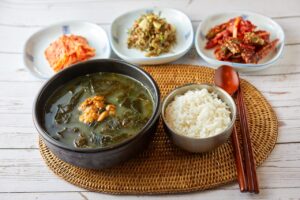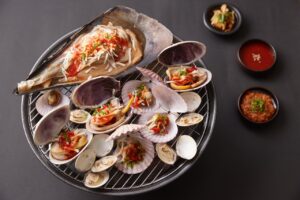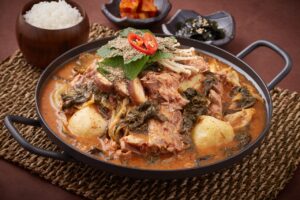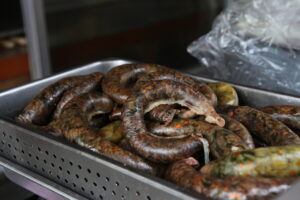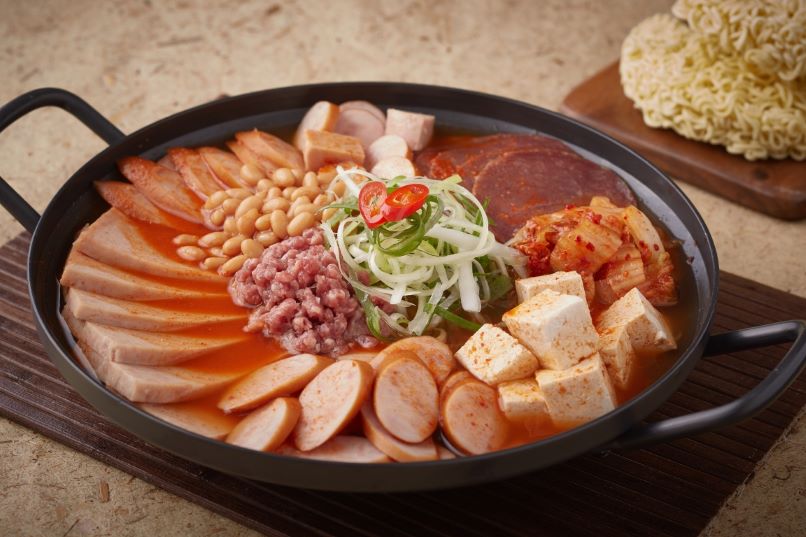
Budae Jjigae -ⓒ한국관광공사 사진갤러리-디그램
History of Bujae Jjigae
Budae jjigae, also known as “Army Stew,” has a fascinating history that is closely tied to the socio-economic and cultural context of post-Korean War South Korea. The dish’s creation reflects a blend of necessity, resourcefulness, and the blending of culinary influences. Here’s a brief overview of the history of budae jjigae:
Post-Korean War Scarcity: The Korean War (1950-1953) left South Korea devastated, both economically and socially. Food scarcity was a significant challenge, and people had to find ways to make do with limited resources. During this period, food rations and surplus items from U.S. military bases played a role in shaping the creation of it.
Origin of the Name: The term “budae” (부대) translates to “army base” in Korean, and “jjigae” (찌개) means “stew.” The name “budae jjigae” reflects the dish’s origins, as it was created using ingredients that were commonly found near U.S. military bases.
Creation and Influences: As the story goes, Koreans started using surplus processed meats, such as spam, sausages, and hot dogs, which were abundant in American military rations. These meats were combined with Korean ingredients like kimchi, tofu, vegetables, and instant noodles to create a hearty and flavorful stew. The combination of Korean and American influences led to the unique fusion nature of it.
Shared Nostalgia: Over time, this evolved from being a necessity-driven dish to a popular comfort food that holds a sense of nostalgia for many Koreans. It became a symbol of resilience and adaptability in the face of challenging circumstances.
Cultural Significance: It is not only a culinary creation but also a cultural artifact that reflects the post-war history and the enduring spirit of the Korean people. It showcases how food can adapt to circumstances and become a part of the cultural fabric.
Modern Variations: Today, it is enjoyed by people of all ages and backgrounds in South Korea. While the original version was born out of necessity, modern variations of the dish are available in restaurants and households across the country. Some contemporary versions feature higher-quality ingredients while still retaining the essence of the original dish.
In summary, budae jjigae’s history is rooted in the challenges of post-Korean War South Korea, where resourcefulness led to the creation of a unique and beloved dish that symbolizes both the past and the present.

Budae Jjigae related to the US Army
The names “Uijeongbu Budae Jjigae” and “Songtan Budae Jjigae” are both tied to specific locations in South Korea where the dishes originated. Let’s explore the reasons behind these names:
1. Uijeongbu Budae Jjigae: As previously mentioned, Uijeongbu Budae Jjigae refers to the regional variation of Budae jjigae (Army Stew) that originated in the city of Uijeongbu, located in Gyeonggi Province, South Korea. The name reflects the dish’s connection to the city. “Uijeongbu” (의정부) is the name of the city where this version of Jjigae was created.
The historical significance of Uijeongbu in the creation and popularization of it led to the association of the dish’s name with the city. The term “Uijeongbu Budae Jjigae” signifies that this particular variation of them originates from Uijeongbu and carries the culinary and cultural history of the region.
2. Songtan Budae Jjigae: Similarly, “Songtan Budae Jjigae” refers to a regional variation of Budae jjigae that has its origins in the town of Songtan, located near Osan Air Base in Pyeongtaek, Gyeonggi Province, South Korea. Songtan is another area that has a historical connection to the U.S. military presence in South Korea.
The name “Songtan Budae Jjigae” is derived from the name of the town, “Songtan” (송탄), where this variation of the dish was likely popularized due to its proximity to the U.S. military base. The name reflects the dish’s origin and the cultural context of its creation.
Culinary Identity and Heritage: Both “Uijeongbu Budae Jjigae” and “Songtan Budae Jjigae” highlight the historical and cultural significance of these regional variations of Budae jjigae. These names help distinguish these specific versions from the broader category of Budae jjigae and emphasize their unique connections to their respective locations. The names not only indicate the dish’s place of origin but also contribute to the culinary identity and heritage of these regions.
Cooking Method
Ingredients: It typically includes a wide variety of ingredients, resulting in a diverse and flavorful dish. Common ingredients found in the stew include:
- Processed meats: Sausages, spam, hot dogs, ham, and bacon.
- Canned goods: Baked beans, canned chili, and canned vegetables.
- Korean elements: Kimchi, tofu, vegetables, instant ramen noodles, and sliced rice cakes.
- Broth: The stew is often cooked in a spicy broth made with gochugaru (red pepper flakes) and other seasonings.
Preparation: It is typically prepared in a large communal pot. The ingredients are simmered together in the spicy broth until everything is cooked and the flavors meld together. The resulting stew is rich, spicy, and satisfying, with a combination of flavors and textures.
Serving: It is commonly enjoyed as a shared dish among friends and family. It’s often accompanied by a variety of banchan (side dishes) and served with rice. The communal nature of the dish makes it a popular choice for group gatherings and social occasions.
Modern Variations: While the original budae jjigae was created out of necessity and resourcefulness, modern versions of the dish often include a mix of both traditional and modern ingredients. Some restaurants even offer gourmet versions with higher-quality meats and ingredients.
Budae jjigae reflects a unique aspect of Korean culinary history and culture, showcasing how creativity and resourcefulness can lead to the creation of a beloved and distinctive dish.
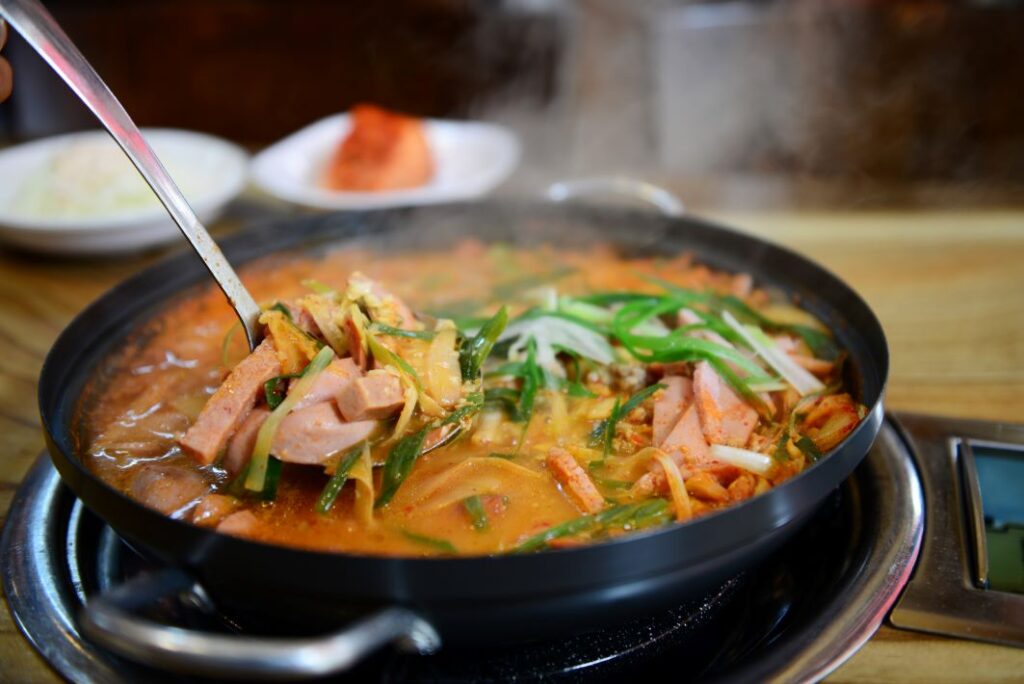
Recommend to Read >> Gimbap: 9 Reasons Koreans Like It

